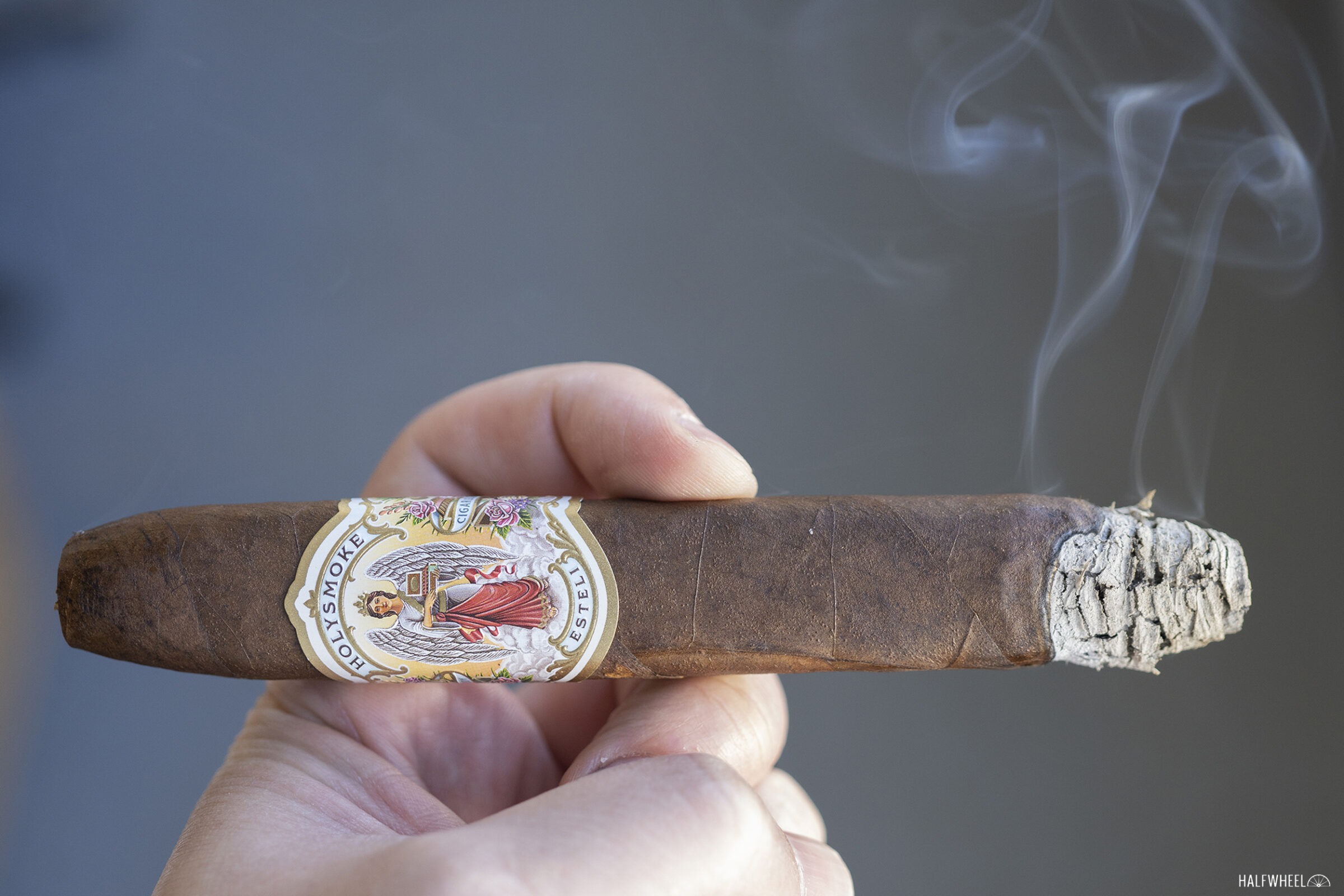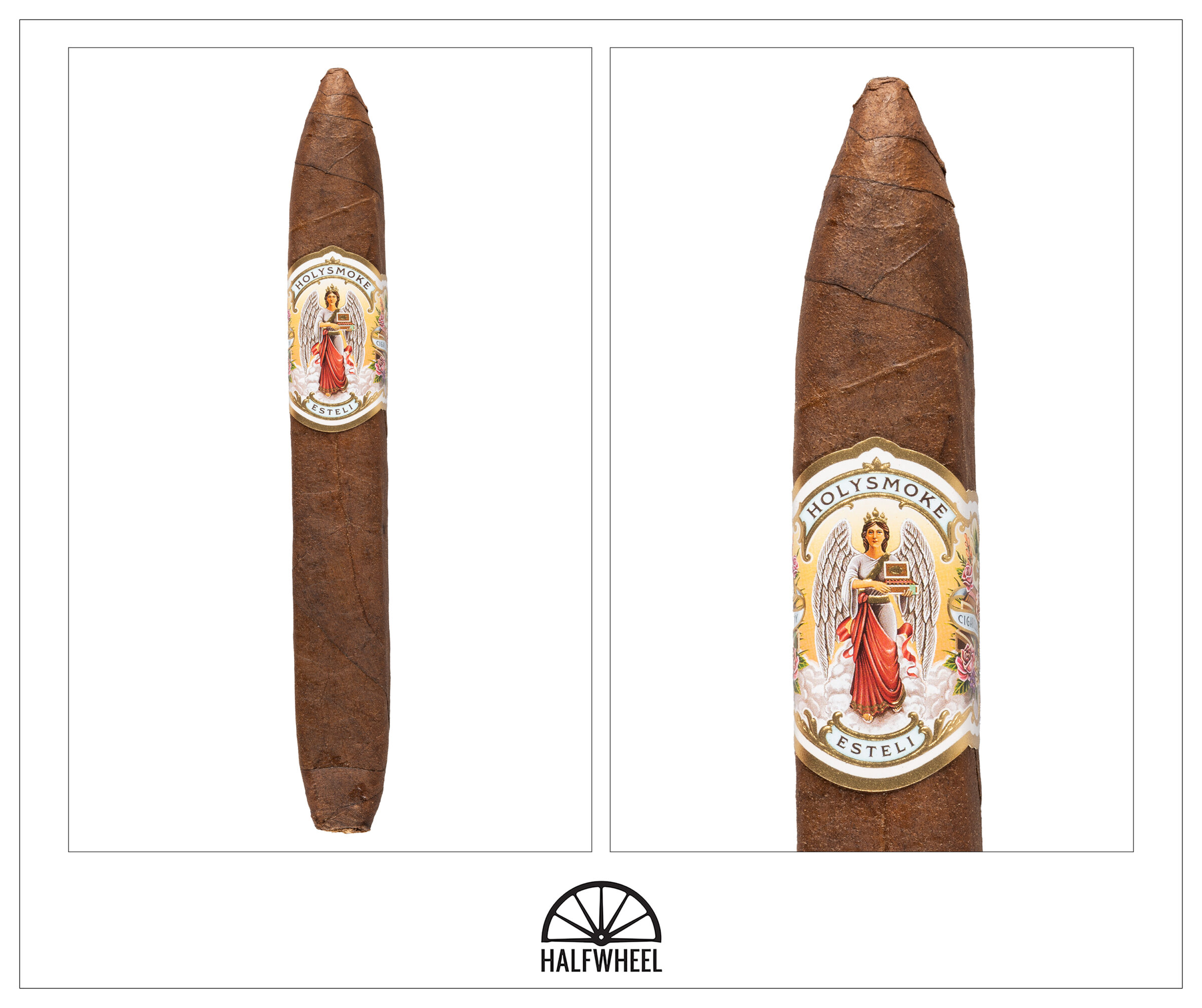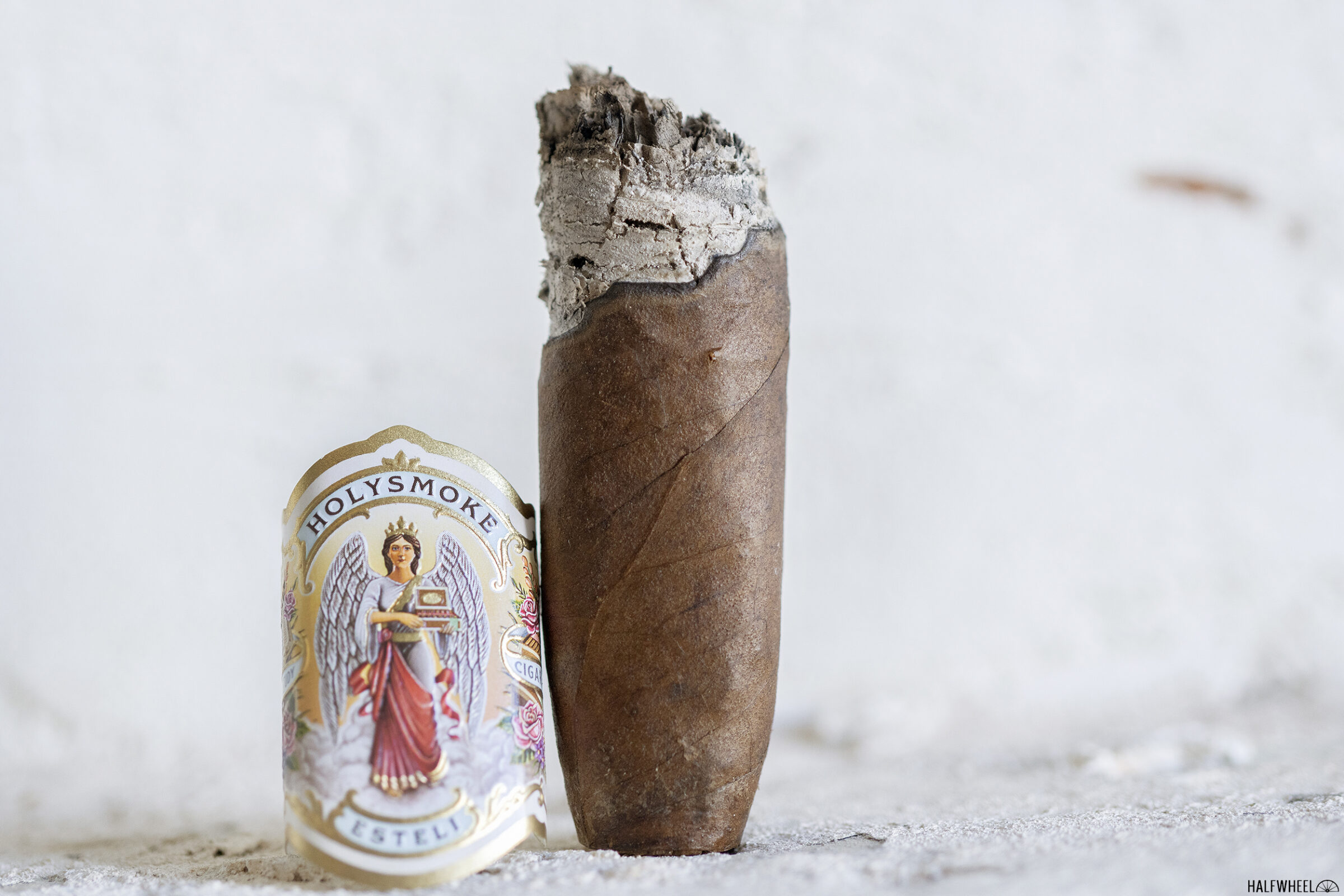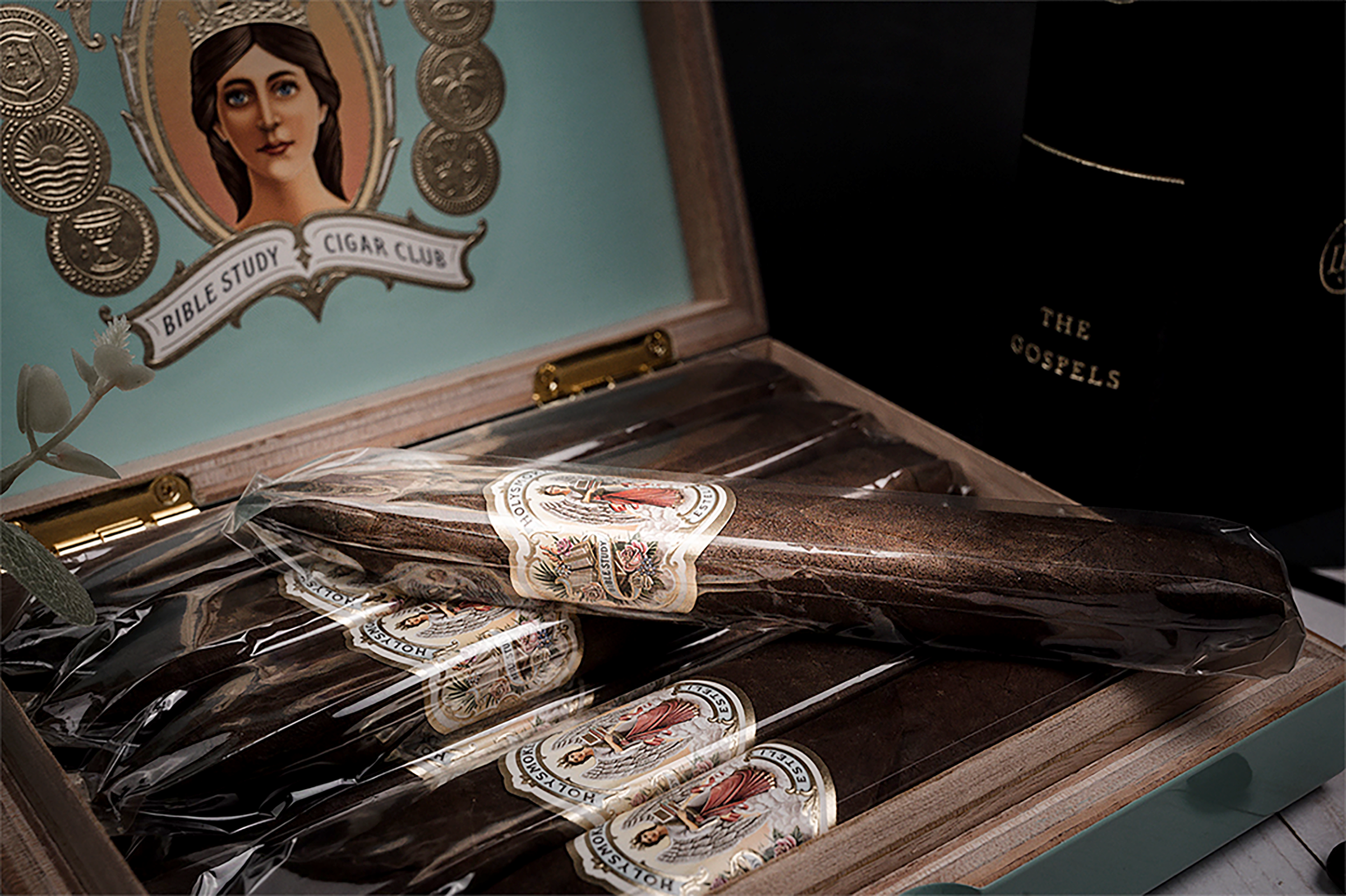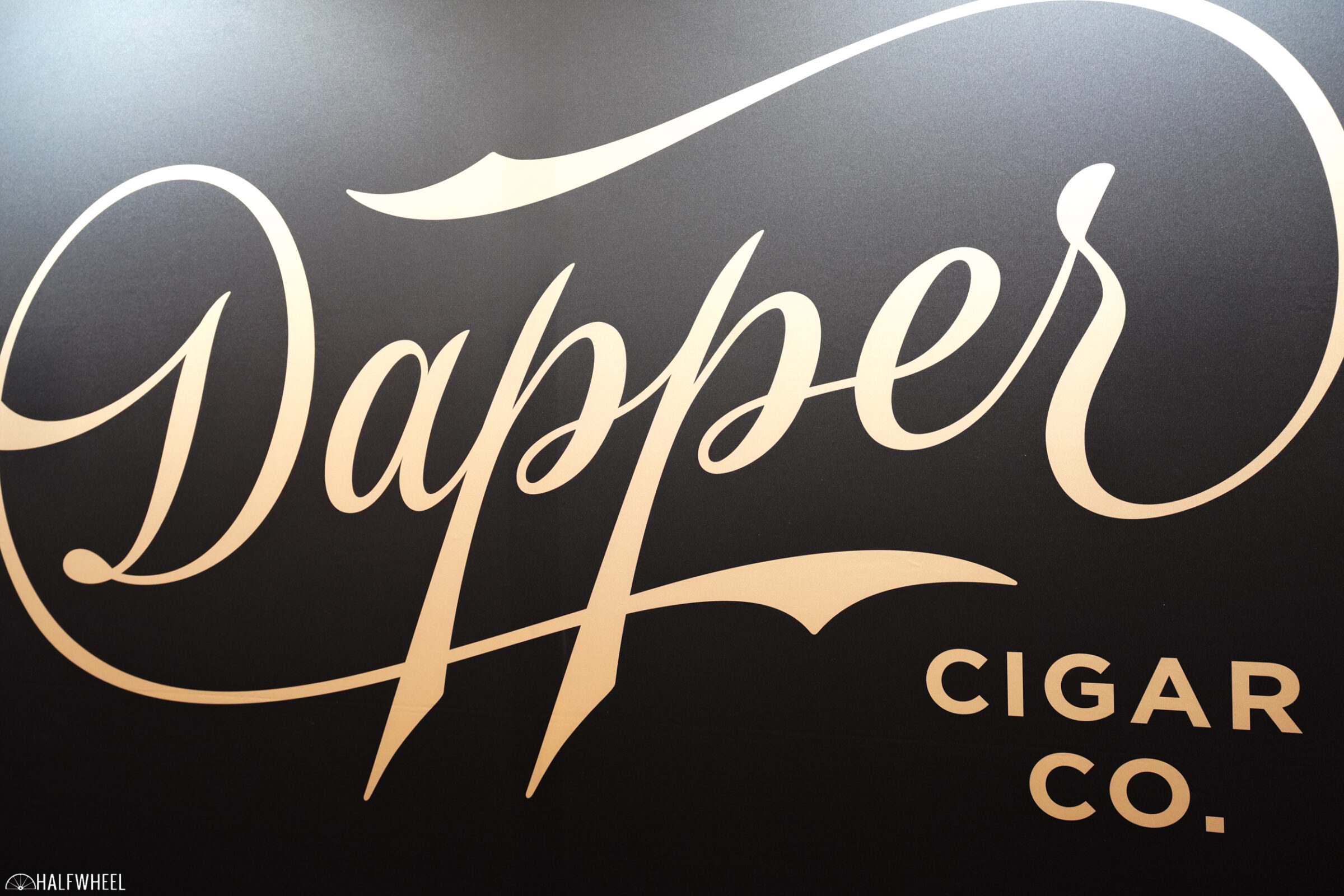In the midst of all the PCA 2023-related product announcements, Dapper Cigar Co. announced a new cigar that wasn’t debuting at the annual mid-summer trade show, the HolySmoke Genesis, a cigar created in collaboration with HolySmoke, a cigar-themed Bible study.
Given the Bible study tie-in, it shouldn’t be too surprising that the cigar is called Genesis, named for the first book in the Bible. It’s a 6 1/2 x 28 x 52 box-pressed perfecto, the first time Dapper has released a cigar in a perfecto shape. It is also the first limited edition that Dapper has produced.
Blend-wise, it uses a Mexican San Andrés over a Nicaraguan binder and fillers from Nicaragua; like many other cigars from Dapper, it’s made at Nicaragua American Cigars S.A. in Estelí, Nicaragua.
“When the HolySmoke group reached out to me nearly three years ago to make them a cigar…I was admittingly a little hesitant,” said Ian Reith, founder of Dapper Cigar Co., in a press release when the cigar was announced in June. “Their cause and their commitment to not cutting any corners in any aspect of the production made the project impossible for me to turn down.”
It is limited to 10,000 cigars, which come in boxes of 12, which is a reference to the 12 apostles of Jesus.
- Cigar Reviewed: HolySmoke Genesis
- Country of Origin: Nicaragua
- Factory: Nicaragua American Cigars S.A.
- Wrapper: Mexico (San Andrés)
- Binder: Nicaragua
- Filler: Nicaragua
- Length: 6 1/2 Inches
- Ring Gauge: 28/52
- Vitola: Perfecto
- MSRP: $16.67 (Box of 12, $200)
- Release Date: June 5, 2023
- Number of Cigars Released: 833 Boxes of 12 Cigars (10,000 Total Cigars)*
- Number of Cigars Smoked For Review: 3
*10,000 isn’t perfectly divisible by 12.
For whatever reason, I thought this cigar was a belicoso, so I’m surprised by its shape once I first see the cigar. Even if I hadn’t incorrectly remembered the shape, this is still a pretty unique size, as aggressively box-pressed perfectos aren’t a common sight. By aggressive, I mean that it is pressed so that the edges are close to coming to a 90-degree angle and the overall proportions have a ratio closer to a candy bar than a cube. If you need a cigar example, think of a Padrón 1926 80th Anniversary. The wrapper on the HolySmoke Genesis is pretty dark with a somewhat sandpaper-like texture to it. A dry milk chocolate leads the aromas from the wrapper, followed by a rotating cast of secondary notes that includes acorns, generic soap, acidity and pork-like meatiness. While the secondary notes change, the intensity is pretty consistently medium-plus. The feet of the cigars are medium-full with a sweeter, almost hot cocoa-like milk chocolate, which leads hickory barbecue, Nilla wafer sweetness and orange citrus. One cigar has cocoa on the cold draw, but the other cigars are led by raisins over leather, Cap’n Crunch cereal, sugar cookies, acidity and, on one cigar, something that reminds me a bit of ranch dressing. Depending on the cigar, it’s medium-full to full.
After all that chocolate, I am surprised that there’s none of it once the HolySmoke Genesis is lit. Instead, lots of earthiness and woodiness lead dry minerals and creaminess. While that sounds a bit pedestrian, the flavors are extremely complex. For example, my notes between the cigars indicate sawdust and burning woods as part of the woodiness. All three cigars are led by earthiness, but they aren’t consistent among themselves. One cigar has mineral water flavors along with herbal flavors and acidity. Another is largely earthiness and sharpness, a combination that isn’t as appealing. The third cigar has a woodiness that almost matches the earthiness, generic sweetness and a touch of creaminess. As the finish develops, I find that sweetness reminds me of unripe bananas, though I’m skeptical of using “banana” as a flavor as it’s known for having an extremely subtle taste that is almost placebo-like. Herbal flavors, mayonnaise-like creaminess, generic creaminess and acidity round out the list of non-earthy flavors during the finish, though there’s still a lot of earthiness. That extends to the retrohales, where the earthiness and some muddy and mineral-like characteristics. I also found burnt flavors, white pepper and some salted cracker flavors. One major difference between the main flavors and the retrohale is that the latter has a velvety texture to the smoke. The finish seems to intensify whatever is happening on the retrohale, which I’m fine with on two cigars, though the cigar that has the sharpness gets too sharp. Flavor is medium-full, body is medium-full and strength is medium. Construction is fantastic on all three cigars as all the different aspects are great, though the evenness of the burn is the most impressive component, if ever so slightly.
While I think each cigar was noticeably different than the other two during the first third, those differences become more obvious in the second third. Earthiness is the strongest flavor on the first cigar, joined by secondary notes of charred earth, something that reminds me of chlorine, grassiness, toasted sourdough bread, brown sugar sweetness and some rocky mineral flavors. The second cigar remains too sharp for my liking, though with lots of earthiness and, at times, toastiness. There’s added woodiness and chalkiness, which helps calm down the sharpness, but the earthiness is still too sharp. The final cigar has a unique pencil lead flavor intertwined with a creaminess that beats the earthiness for the top spot. Underneath are walnuts and, to lesser degrees, leather and white pepper. The first and third cigars see peanut flavors build as the second third progresses, eventually—but at very different times—getting to the point where they are the strongest flavors. The peanut flavor takes command of the finish, edging out minerals, charred earth, burnt black pepper and a generic earthiness. As the final third of the first and third cigars approaches, the peanut shells begin to be drowned out by herbal flavors, with added touches of white pepper and citrus. Retrohales are where the peanut flavors do their best work, as they are vibrant and taste like both the nut and the shell. Secondary flavors include a generic nuttiness, spices, starchiness and some lavender. The finish has a weird tingling that reminds me of horseradish, though without most of the bite. The peanut flavors are still the strongest, but the profile has changed a lot thanks to the tingling, meatiness and mineral flavors. One cigar has some faint hints of a waffle cone sweetness. Flavor is medium-full or full, body is medium-plus and strength is medium. Construction remains flawless on two cigars, though the cigar that is probably the most enjoyable flavor-wise has an uneven burn line and needs a small correction. Otherwise, construction is great.
While the cigar that has had a sharp earthiness continues to be led by that flavor, the other two cigars are going through noticeable changes. For the first time since any of the cigars have been lit, I taste chocolate in one of them. It never beats out the peanuts for the top spot, but it gets close. The third cigar has earthiness and lots of peanuts over saltiness and leather. Fortunately, the sharp earthiness of the second cigar calms down during the finish; unfortunately, that reduction leads to more herbal and metallic flavors. The other two cigars show more toastiness during the finish it’s one building pepper and burnt earthiness. Those two cigars have remarkably consistent retrohales: sunflower seeds and Ritz crackers over creaminess, muted lime and herbal flavors. Some retrohales have a distinct peanut shell flavor, though it’s not consistently present. The finish varies depending on the cigar. One has white pepper, cinnamon, Ritz crackers, herbal flavors and acidity. The second cigar—i.e., the one dominated by sharp earthiness—has more mineral and grassy flavors with toastiness binding the two flavors together. The third cigar has more sweetness and harshness—an interesting contrast—along with mineral flavors that slowly drown out the peanut flavors. Flavor is medium-full or full, body is medium-plus and strength is medium. after the one touch-up in the final third, construction returns to being excellent.
Final Notes
- Most companies only include one ring gauge number for a perfecto. In this case, 28 references the cigar at its opening, while 52 references the ring gauge at its widest point.
- Without question, construction was this cigar’s best attribute. That’s not a knock on the flavor per se, rather, there was just one deduction made between the three cigars for construction, a lone touch-up in the final cigar. Construction was what I’d hope a cigar to be, which not only makes the cigar better because it’s in better physical condition, but as the consumer, it’s more enjoyable as I don’t have to be concerned with it.
- The ash is extremely firm, to the point where getting it to fall off the cigar requires more effort than normal. I don’t think this is a bad thing as it made for considerably less mess than normal.
- That said, if there was one aspect of construction I would change, it would be getting a tad bit more smoke production at times. For most of the cigar, it was fine, but there were some stretches when I wanted more smoke in the mouth.
- On the flip side, the worst part of the three cigars was the flavor of the second cigar: too sharp, too earthy and too dry.
- Dapper’s bands tend to be well executed and often have a lot of elements; this is no different. Some standout features include the angel holding the box of cigars, as well as the Bible verse on the side of the band.
- The spot where the Bible verse is printed is where many Cuban bands show the ring gauges that a particular band will fit. In the non-Cuban cigar world, Cigar Rings—a band printer—will oftentimes print its logo in that spot.
- I was curious to see if there were different bible verses printed on the bands, but all three cigars I smoked had John 10:10.
- As for that Bible verse, there are numerous translations, but in the New American Bible it says, “A thief comes only to steal and slaughter and destroy; I came so that they might have life and have it more abundantly.”
- Cigars for this review were purchased by halfwheel.
- Final smoking time was one hour and 45 minutes on average.
- Site sponsor Atlantic Cigar Co. carries the HolySmoke Genesis.
Just as I was about to light up the third and final cigar I smoked for this review, Brooks asked me how this cigar was. I told him the first cigar was good, but unfortunately the second cigar was too sharp and too earth-dominant. Fortunately, the third cigar had the best flavor of the bunch, so I’m not leaving this review on a sour—err, sharp earthy—note. At its best, the HolySmoke Genesis can be a good cigar, though short of a very good cigar. For better and worse, Dapper’s “very good” cigars have set the bar for the brand pretty high and I don’t think this really ever comes close to those, except maybe in construction.

